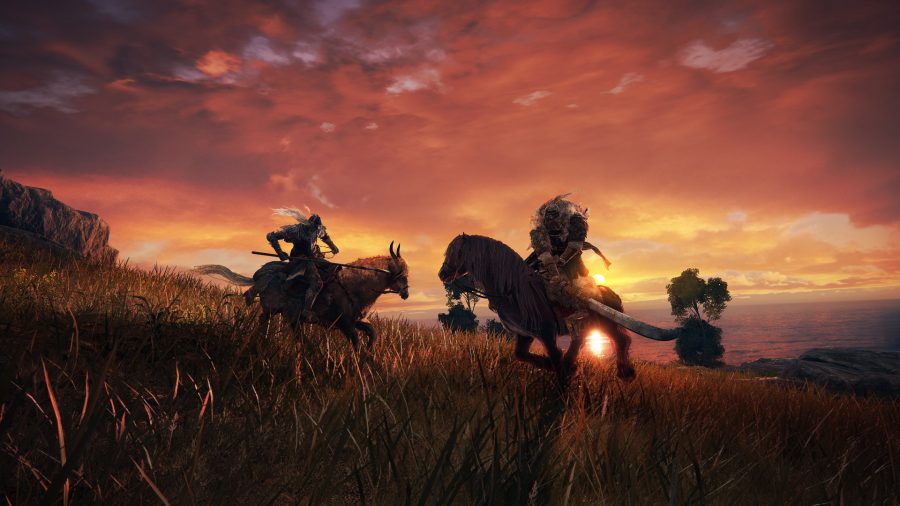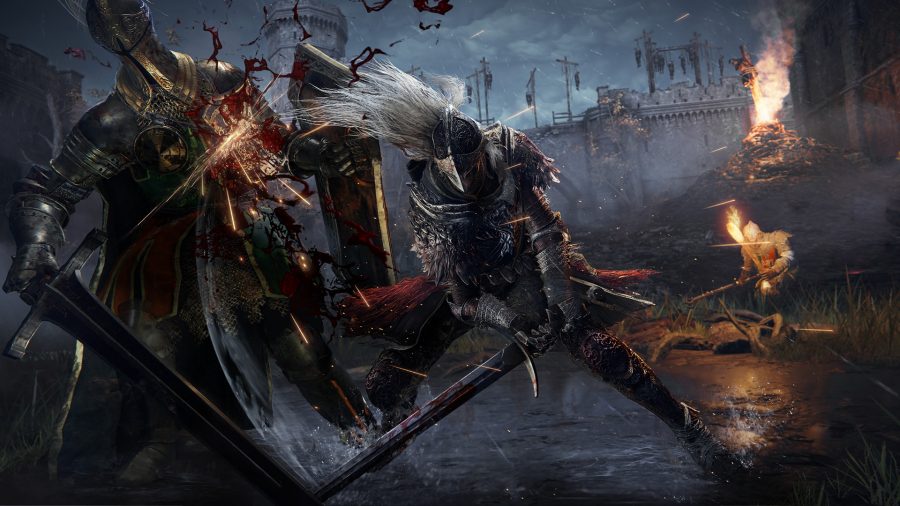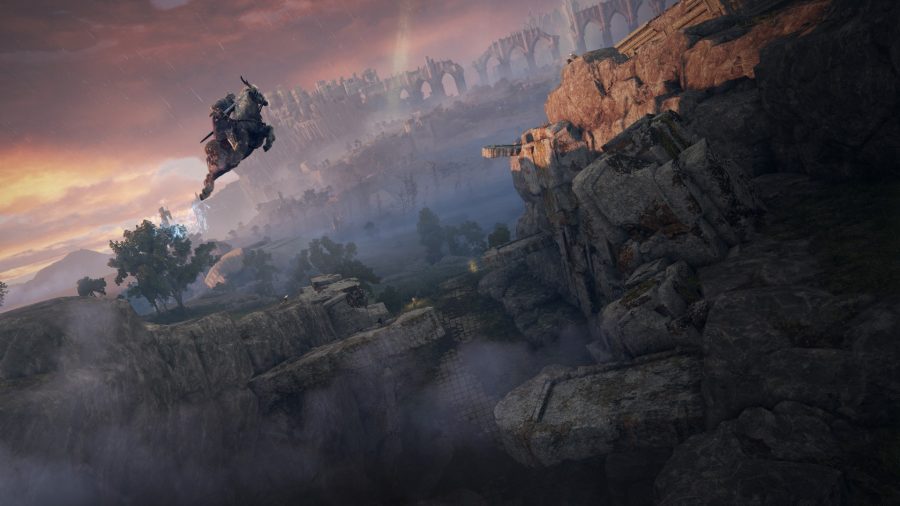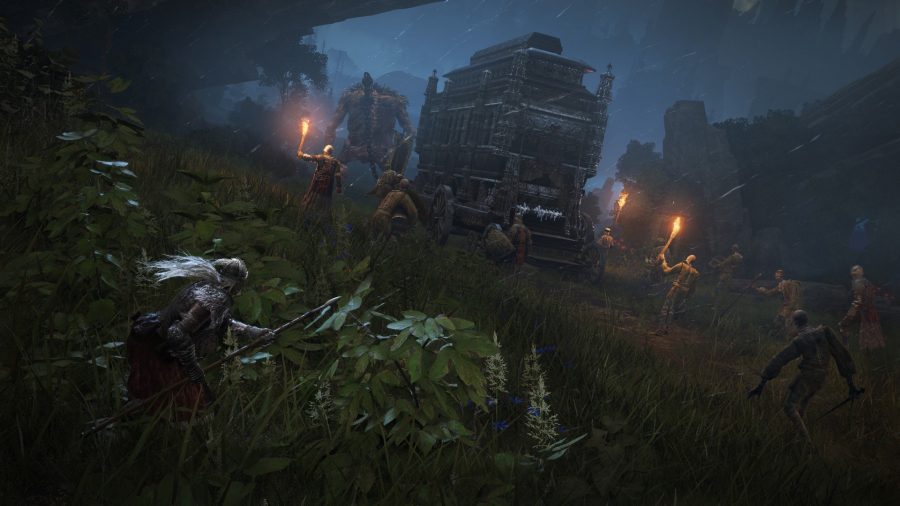When an established series takes a creative risk, you can generally expect some scepticism, perhaps even outright dismay. And the decision to eschew the linear-but-branching structure of FromSoftware’s recent hits in favour of an open world is indeed a risk; the tight direction of the player’s experience that such a structure affords, is a big reason those games work so well. But I don’t recall much gnashing of teeth when it was announced.
Perhaps that’s because George R.R. Martin’s involvement stole a lot of the oxygen, but I’m also sure From’s track record has something to do with it. The studio has dropped more bangers than Wile E. Coyote since Demon’s Souls in 2009; does anyone seriously doubt that it can pull this off?
After three days with Elden Ring’s closed technical test – available to selected applicants this coming weekend – I’m certain the believers will be vindicated. In fact, I’m not sure I’ve ever been more impressed by a game demo.
The first ‘holy cow’ moment comes after I exit the Cave of Knowledge, a tutorial area covered in hint messages like Dark Souls 2’s Things Betwixt. Throughout that cave you could’ve convinced me I’d been playing some new Dark Souls 3 DLC, but when I open the doors to the Lands Between, Elden Ring asserts itself emphatically. It’s so damn beautiful.

Trees the colour of autumn rust are scattered among slate rock and emerald bushes. In the distance, a castle crowns a cliff of the same hexagonal regularity as the Giant’s Causeway, but stretched hundreds of feet to the sky. And in that sky looms a cosmic gold tree, bathing the world and the clouds in a watercolour wash of green-gold. Some time later I’m exploring an island at sunset, and I catch a splash of fiery red glinting on my armour. This is when I discover that Elden Ring’s day/night cycle means you can literally watch the sun go down in real time, and I just stand there and do that for a couple of minutes. It paints the clouds, the sea, and the cliffs of the mainland in a breathtaking orange and red bloom.
It’s enough to put other fantasy open worlds in a new context. I got similar chills when the Northern Lights hit Skyrim’s Throat of the World just so, but it doesn’t come close to this. The Witcher III’s rainswept wilderness has its own rugged beauty, but feels similarly limited.
Yes, Elden Ring is high fantasy where those are not – the giant glowing tree in the sky is a bit of a giveaway – but somehow it doesn’t feel overdone. The columns in these ruins are slightly too tall, that moon in the sky is slightly too bright and big. It’s dialing everything up to a tasteful 11 (alright, maybe 12) rather than the kind of unapologetic indulgence you’d see in Warhammer Age of Sigmar’s concept art. World of Warcraft is possibly the closest comparison, but obviously it’s ancient, and never aspired to this kind of near-realism stylistically.
If the full game maintains these standards Elden Ring may be among the most beautiful open-world games ever made, and it won’t be because it can match Red Dead Redemption 2’s awesome scope or its visual fidelity – it hasn’t, so far – but because it’ll be the first fantasy game that’s made such effective use of its licence to be fantastical. It delivers vistas that couldn’t exist in our world, but without entirely losing its grounding in reality. Its otherworldliness is expertly deployed.
Just as I think these thoughts, I see an ordinary-looking sheep curl up into a ball and roll across the ground like an armadillo. I’m in love.
FromSoft develops its previous gameplay with the same deft touch. Sekiro’s ability to jump returns, enabling more ‘hitbox porn’ and new attacks in combat, while its stealth systems allow me to sneak around a ruined village taking out men-at-arms. Then I get spotted, someone blows a trumpet, and the whole village mobs me. I answer with my own squad: a quintet of wandering nobles.
You can collect the ‘ashes’ of certain enemy types and summon a spirit version of them to help you out. It’s only available in particular areas, such as boss fights and tricky encounters like these in the open world, and it may, finally, lay to rest the conversation about difficulty that plagues every FromSoft release. Spirit ash summons are controlled by the AI, so they don’t depend on other players’ willingness to drop a summon sign, and they only cost focus points (aka, FP, the same easily replenished currency you’ll use to cast skills or spells) rather than limited-use items like humanity.
After my first run at a boss ends rather ignominiously, I decide to take my new Northern Mercenary spirit ash for a spin. He costs almost all my FP, but together we absolutely crush the boss – it isn’t even close. Players after a challenge will still find it by following the same ‘no summoning’ rules they always have, but for anyone who just wants to progress, the means to do so are more accessible and reliable than ever, while remaining consistent with the wider game world.
Back in the village, my squad of wandering nobles costs me much less FP, but they’re far weaker, and serve mainly as distractions to keep me from getting swarmed. The resulting fight differs greatly from previous FromSofts due to its body count: there are more than a dozen of us shambling or rolling around these charred houses, swinging swords, grunting, and drawing those distinctive splashy noises when blades strike flesh. This is a battle, when most fights in Dark Souls are duels.
The other difference in combat is one of scale. Torrent, your horse – more specifically, your Spectral Steed – is a necessary means of conveyance around the open world, but From has integrated him meaningfully into combat too. The lance has appeared in Dark Souls games, but now fulfils its intended use, as you can hold R2 to couch it and deal damage when charging into enemies. You can of course swing a sword from horseback, taking out undead in ride-by stabbings. I only manage to beat Flying Dragon Agheel, the network test’s optional superboss, because Torrent’s speed enables me to escape its fiery breath, and when I kill some towering trolls towing a grand carriage, I outrun their clumsy swings by tapping the sprint button, kicking the horse into an intoxicating lurch of speed.
 Elden Ring Elden Ring $59.99 Pre-order Network N earns affiliate commission from qualifying sales.
Elden Ring Elden Ring $59.99 Pre-order Network N earns affiliate commission from qualifying sales.
It’s all brilliant and new and exciting, but FromSoft diehards needn’t worry about missing more traditional experiences. This part of the Lands Between is called Limgrove, and it’s a very large open-world area, but it hides plenty of linear dungeons that play just like Dark Souls. A tangle of catacombs is reminiscent of Bloodborne’s chalice dungeons, and haunted by deeply annoying stone grotesques who like to hide around corners and ambush you. It’s classic FromSoft.
There’s really only one major difference in Elden Ring in these encounters, and it’s the closest I’ve got to a criticism: the guard counter. This is a new manoeuvre which lets you tap R2 for a quick and powerful counterattack just after blocking an enemy’s hit. Against ordinary enemies it’s almost risk free, breaks through their own blocks or shields, and does nearly enough damage to kill in one blow. It’s a bad idea against groups or if your opponent hasn’t finished their combo, but otherwise I’m a bit worried that it’ll incentivise a passive style of play: hold up a shield, wait for them to attack, win.
It also does significant poise damage, so it’s very helpful against bosses. When I finally triumph over Margit the Fell, the final boss of the area, it’s because I land critical hits after staggering him with guard counters and jump attacks – twice. After beating him I make my way further into Stormveil Castle, where I run across a vaguely Patches-like NPC and a series of wooden platforms, laden with oil barrels and squeezed tightly between the castle walls. It’s a surely deliberate throwback to a similar sequence in world 1-1 from Demon’s Souls, and I know what to expect even before the enemies on the platforms above throw their first firebomb.
I crack a smile. Elden Ring isn’t forgetting its roots – far from it. How odd that returning to such a hostile world can feel so comfortingly familiar.




